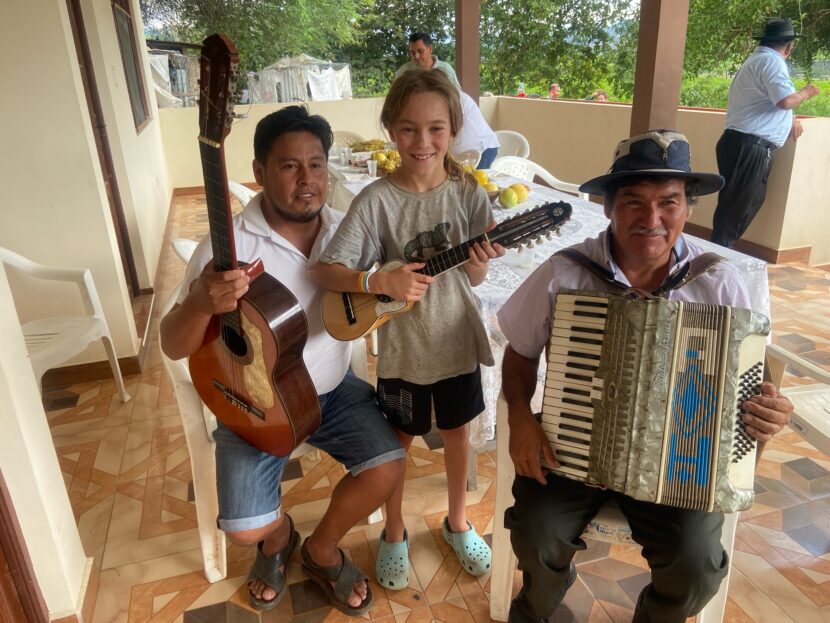“Mom, can I please tell the tear gas story?” Talon asks, bouncing impatiently on the patio as he wait for his grandparents to answer the phone.
I hesitate, torn between not wanting to alarm my folks and wanting the kids to be able to share their travel experiences. Retelling the stories from our trip — good, bad, ugly — anchors the memories in their little brains. “How about a short version?”
Talon launches in. “There’s this big park by the house where we’re staying in Sucre. It has all these trees and a giant playground and rides for kids! One morning there was this protest with all these people marching. But Bolivia doesn’t like it when people protest. So the police shot tear gas at them to make it stop. Then we had to flee the park.”
Lyra chimes in. “And we had to be really careful when we crossed the street because it is really busy here in Spanish World.”




True story. Aside from mild panic and some briefly stinging eyes, everyone was safe.
We chose to spend 10 days in Sucre, the Constitutional capitol of Bolivia, because it’s touted as the most tranquil city in the country. (We just happened to unluckily stumble upon a rare moment of political unrest.) Sucre is also one of the most beautiful cities in South America. Four-hundred-year-old white stucco and red-tiled buildings decorate the 9,000-foot-high hills. Narrow streets wind steeply through markets and parks. It looks more like Spain than Bolivia.
Our homestay with a local family went swimmingly…except for that first hour when Lyra put her face too close to one of their sleeping pet dogs. No stitches needed from the dog’s quick nip, but many more grey hairs bequeathed to Mama. The dogs and kids got along merrily the rest of the time, and Talon and Lyra played hours of board games, volleyball and tug-of-war with the two Bolivian teenagers.
In Sucre, we all took a few spanish lessons. We walked to Parque Simon Bolivar each day for (excellent) coffee and took a spin on some of the dozens of playground attractions. We wandered the endless mercados, returning home with bags of fresh produce. The kids got to see the best-preserved dinosaur footprints in the world and also saw how chocolate is made. We watched a jaw-dropping dance performance and ate salteñas to our hearts’ content.



But let’s back up for a minute to catch you up on our other Bolivian adventures. Before Sucre, we spent a few days in Bolivia’s biggest city, Santa Cruz, sweltering in 98-degree heat. We made friends with our taxi driver and his family, who took us to a wildlife refuge, dinner, the river and a playground. The kids held hands with spider monkeys and spotted a sloth in a tree.
Next, we moved up in elevation to spend a week touring the agricultural valleys between Samaipata and Santa Cruz. A friend of mine who runs Fundacion Natura Bolivia set up a press tour so I could learn more about ecological conservation efforts underway here, which entailed hours (and hours and hours) of driving on windy dirt roads, eating many chicken and potato meals in very rural villages, dodging wandering cows, and listening politely to lots of speeches in spanish from farmers, mayors and biologists.
The kids were champs through those long days. My brain almost exploded from all the input, but it was a good trial-by-fire for remembering my spanish. Plus, we got to see the endangered red-fronted macaw, which is maybe the prettiest bird ever.
Bottom line, it’s been a full three weeks here in South America! The Bolivian people are a lot like Montanans: kind, proud, capable, friendly but not pushy.




One lesson I keep relearning for myself: living in a foreign land is not nearly as relaxing as living aboard a sailboat in the Bahamas. I have many words to describe our travels here: challenging, rewarding, enlightening, stressful, frustrating, terrifying, exhausting, enriching, amazing.
But none of those words include peaceful, calm or easy. We are constantly vigilant here, whether it’s to avoid zooming motorcycles or dog poo on the sidewalk. And our brains are constantly working to make sense of the new customs or geography or accents.
Is it worth it? Yes. The stories we live here—and retell to all of you—forge us anew.
Tomorrow we’re off to an ecolodge in Madidi National Park in the Bolivian Amazon, one of the most biodiverse places on earth. Our week there will probably be hot and rainy and buggy. And it will also be full of really amazing stories.

